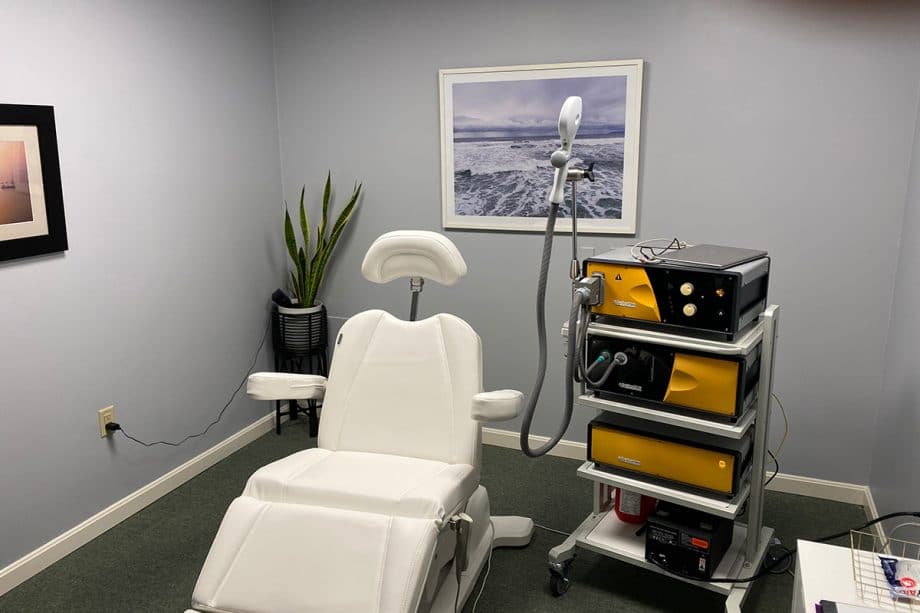Transcranial Magnetic Stimulation (TMS) is a non-invasive procedure that uses magnetic pulses to improve the symptoms of depression. Additionally, TMS may help treat obsessive compulsive disorder and other conditions. Often, it is used when other standard treatments fail to provide relief.
The name of the procedure can make it sound complex. However, Transcranial Magnetic Stimulation is a simple process that may be performed in your doctor’s office. It requires no anesthesia, no sedation, and no surgery. Here’s how it works.
How Transcranial Magnetic Stimulation Works
Imagine if you could target the parts of your brain that impact mood and depression and stimulate them to make you feel better. In a nutshell, this is how Transcranial Magnetic Stimulation works.
In order to achieve these results, doctors deliver brief, painless magnetic pulses to specific nerve cells in your brain using an electromagnet. An electromagnet is a magnet that runs on electricity and can be adjusted to change the amount of electric current running through it.
When the magnetic pulses are sent in a repetitive manner, this can impact your brain’s function. As a result, you may see an improvement in your mood and a lessening of depression symptoms.
What Happens During Transcranial Magnetic Stimulation Treatment?
Typically, you begin with an appointment where your doctor can set up and start delivering your treatment. You can expect to be sitting in a chair, like a dentist’s chair, and you may be given earplugs to wear during your procedure.
Once you are comfortably seated, the doctor will:
- Place a cloth cap on your head and take measurements to determine the specific locations for treatment.
- Deliver brief, painless magnetic pulses over the treatment area to determine the right amount of magnetic energy for you.
- Once measurements and energy level are confirmed, the doctor will deliver 19 minutes of pulses. You will be awake the whole time, and it may feel like tapping on your scalp, even though the scalp is not actually touched.
It’s important to know that this procedure typically involves a series of treatments. The first appointment is the longest, usually taking about an hour or so.
After that, treatments typically continue for 20 minutes every weekday for about a month. The good news is that you can plan to drive yourself to and from your appointments and maintain your regular activities. This means you can continue working and living your daily life throughout the treatment process.
When is Transcranial Magnetic Stimulation Used?
TMS is typically used after other standard treatments have failed. Your doctor can talk with you about your options and other approaches you may have tried.
For example:
- Have you tried psychotherapy without success?
- Have you taken multiple trials of antidepressants without relief in your symptoms?
If the answers to these questions are yes, then TMS may be an option for you.
There can be a number of different factors to consider with your doctor before starting TMS. For instance, are you pregnant or planning to become pregnant? Or do you have an implanted medical device?
These are some of the many personal health factors that may impact whether TMS is recommended for you.
Benefits of Transcranial Magnetic Stimulation
If you’ve been struggling with depression or other conditions and have not had success with standard treatments, Transcranial Magnetic Stimulation may help relieve symptoms or stop them altogether.
Unlike some other treatments, TMS does not require sedation or surgery, and it is generally well-tolerated. Side effects like fainting and seizures are rare. However, some people may experience mild side effects like site tenderness and dizziness.
Transcranial Magnetic Stimulation: What to Know
Finding a treatment that works for you can take time, and it can be frustrating when you don’t get the results you want. For many, but not all patients, Transcranial Magnetic Stimulation can offer meaningful symptom relief.
Research shows that:
- 50% to 60% of people with depression that haven't responded to previous treatment see a clinically meaningful benefit from TMS.
- Approximately one-third of patients who have success with TMS experience a full remission of their symptoms.
As with other treatments, it’s important to realize that results can vary based on each individual patient. After completing Transcranial Magnetic Stimulation, some patients may participate in ongoing therapies for depression, such as medication or psychotherapy; others may not.
Also, repeat sessions of TMS may be a possible option to help maintain the benefits of symptom relief.
Transcranial Magnetic Stimulation has been in widespread use since 2008. With time, doctors are continuing to learn more about its uses to help patients live their best possible lives.
Interested in Transcranial Magnetic Stimulation?
If you are interested in learning more about Transcranial Magnetic Stimulation or how it may benefit you, then the team at South County Psychiatry is here for you. Visit us online to read more about TMS, or contact us at 401-343-4343 . You may also request an appointment online.
Let us help you find treatment that works for you.

